Lobelia: planting and care, growing from seeds
 Lobelia (lat. Lobelia) is a genus of perennial and annual sub-shrubs, shrubs and herbaceous plants in the family Campanulaceae, although some scientists include them to the family with the same name – Lobeliaceae. The lobelia plant was named after the Flemish botanist Matthias de Lobel who was the superintendant of the royal botanical garden during the reign of James I.
Lobelia (lat. Lobelia) is a genus of perennial and annual sub-shrubs, shrubs and herbaceous plants in the family Campanulaceae, although some scientists include them to the family with the same name – Lobeliaceae. The lobelia plant was named after the Flemish botanist Matthias de Lobel who was the superintendant of the royal botanical garden during the reign of James I.
The lobelia flower grow almost in all parts of the world, but most of all it occurs in the subtropics and it can be rarely found in temperate zones. In total today there are about 300 species of lobelia. Some of them are raw materials for the production of drugs used to cure diseases of the lungs. In cultivation about 20 species of lobelia are used. Growing of lobelia and caring for it are not tiresome, so buy the seeds with confidence and decorate your garden with these sweet and cute flowers.
Description of lobelia flower
In cold climate zones perennial lobelia is usually grown as an annual plant. It is a spherical compact shrub, 4-8 inches high, although there are species and varieties reaching a height of 5 ft. The stems of lobelia are thin, branching at the base, densely covered with alternate entire lanceolate leaves. The axillary bilabiate flowers on short flower stalk and 0.8 inch in diameter come in color of white, purple, dark blue, violet or blue, depending on the variety. The flowering usually begins in June and lasts until September, producing lots of fruits that are many-seeded capsules. Seeds of lobelia retain their germination capacity to three years. The plant has been cultivated since 1861.
Growing of lobelia from seeds
Lobelia sowing
Growing of lobelia begins with seed sowing, since the main way of propagation of lobelia is by seeds. It blooms in 8-10 weeks from the moment of its sowing. Usually a seedling method of seed propagation is used. In the first days of February, place a layer of drainage (claydite or pieces of bark) in a seed starting tray with a 2 inch deep cells, fill it with a light, well mashed soil mixed with coconut fiber and river sand, water the soil to saturate it with moisture and make it compressed, and scatter the seeds mixed with sand over it. It is not necessary to bury seeds in the ground, since they might not sprout from the soil, you should only lightly cover them with a thin layer of sand for the moisture not to evaporate so quickly from the soil. Cover the tray with foil or glass and put it in a place with the bright scattered light.
Lobelia seedlings
Lobelia seedlings tolerate well excessive humidity. But they do not stand dry, too warm air and dry soil – they immediately get thinner and die. Therefore, do not leave the tray without a foil, if the room temperature is 72 ºF or more, and strictly follow the watering schedule. For the seedling not to get cold or overwatered water them from the bottom up. A cool air will not kill your seedlings as they can withstand even 28 ºF. The first month sprouts will grow very slowly, almost imperceptibly, but then the growth will get faster. As soon as the seedlings reach 1.2-1.6 inches in height (and this will happen in about two months after sowing), prickle them out by 3-4 pieces into a 3.5 fl oz disposable cup, and when the seedlings are 2.4-2.8 inches high, pinch them to promote the bushier growth. Lobelia seedlings may even start blooming.
Planting of lobelia
Planting of lobelia in the ground usually happens in the second half of May when the spring frosts have passed. The site should be in full sun, and the soil should be loose and not too fertile (sandy loam or loamy). When preparing the planting site, do not overuse nitrogen, otherwise you will get a beautiful green foliage, but the lobelia flowering will not be profuse. In each planting hole transfer 3-4 small lobelias with the soil clod, and the distance between the holes should be 4-6 inches.

Growing of pendant lobelia also begins with sowing of the seeds to get seedlings and it is carried out in the same way, but the seedling should be planted out not in the garden, but in hanging flower pots or baskets. Trailing lobelia is used at home to decorate interior and exterior space, balconies, loggias and outside windowsills.

How else can lobelia be grown without using the seed way of propagation? Some flower growers dig lobelia out in autumn and keep it in cold greenhouses until spring, thus making it perennial. The varieties of lobelia that you like can be also kept at home for winter storage: on the eve of spring lobelia bushes that overwintered in a cool light room are taken into cuttings and planted in separate pots for rooting. As soon as the rooting occurs, you can plant lobelia in the ground. The vegetative way of propagation is used in case if you are not sure that lobelia grown from seeds will retain its varietal characteristics.

Care of lobelia
Care of lobelia is easy, and the most important point is watering of the plant, as the soil should always be kept slightly wet, especially in hot seasons. Trailing lobelia requires watering twice a day. The second important point in caring of lobelia is pruning that should be carried out at the end of the first flowering. The stems are cut at a height of 2 inches from the ground level, after which the luxuriant growth of new shoots begins and the second, often even more abundant, flowering occurs. Lobelia is fed with combined mineral fertilizer two or three times during the summer season.
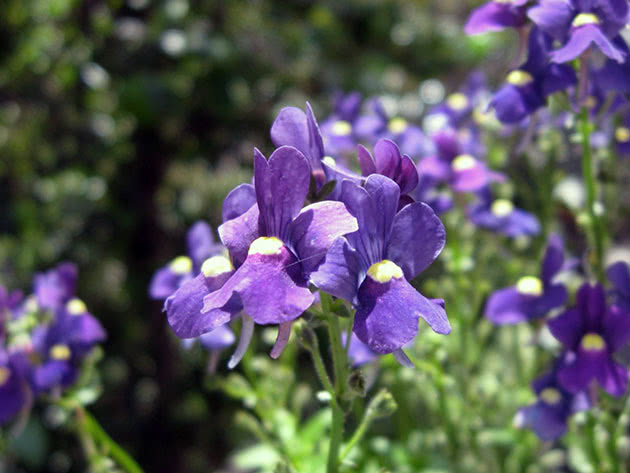
Lobelia after flowering
When lobelia fades, you can treat it as the annual plant and get rid of the remains, collecting the seeds if necessary. And you can leave it as it is, but you should keep in mind that lobelia easily propagates by self-seeding, and with chaos reproduction it will bloom later than spring planted seedlings. It is better to collect the seeds and sow them according to our recommendations. The seeds are collected in the following way: cut off the bush of lobelia, shake it well over the newspaper, and sift what remains on it through a sieve, place the seeds in a matchbox, sign and store it.

Species and varieties of lobelia
There are species of lobelia that are grown only as annuals:
Lobelia erinus (Lobelia erinus)
or edging lobelia, or garden lobelia, or trailing lobelia. This species has five forms: sprawling, dwarf, trailing, upright and compact. The popular varieties are: Regatta Rose and Regatta blue that are respectively pink and blue lobelia, lobelia Riviera Sky Blue have the flowers of sky-blue color.
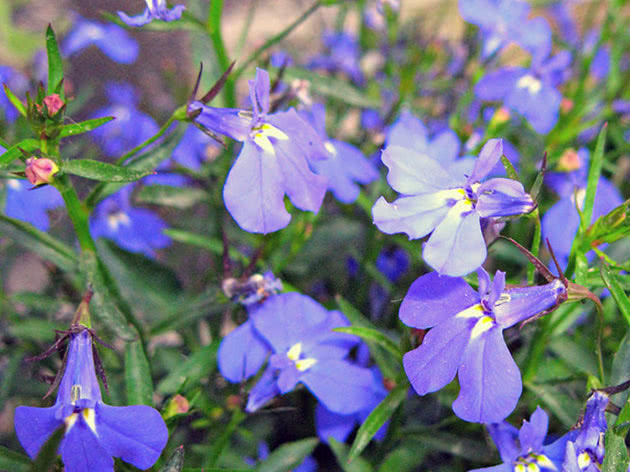
Limestone lobelia (lobelia valida)
resembles the compact form of lobelia erinus, but it is slightly more robust: the stems are more powerful, and the leaves are juicier, and the flowers are also larger, purple or blue with a white spot in the center.
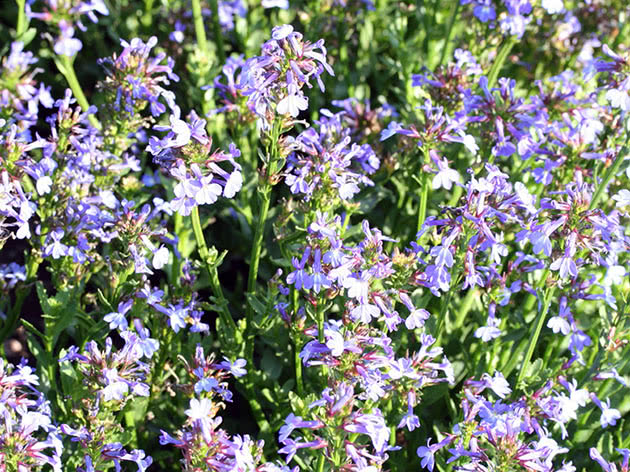
Trailing lobelia Riccardi is larger and rougher than the climbing varieties of lobelia erinus, it is a hybrid variation and propagated only by cuttings.
Slender lobelia (Lobelia tenuior)
is 10-13.7 inches in height, the flowers are up to 0.8 inch in diameter of blue, white or lilac colors.
Cardinal flower (lobelia speciosa) is grown both as annual and as perennial.
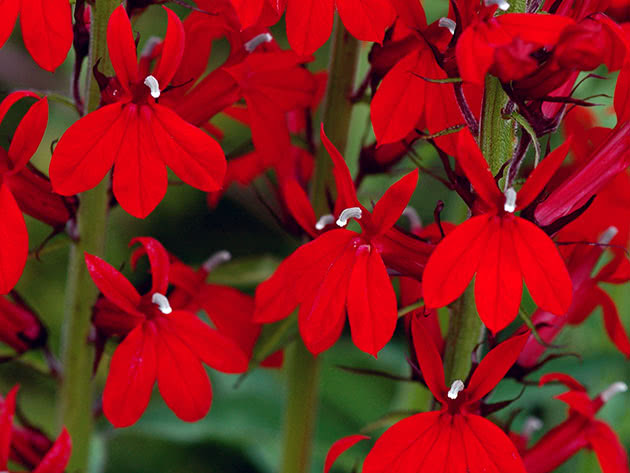
Perennial lobelia is represented by such species:
Lobelia fulgens
reaches 2.5 ft in height, depending on the variety the leaves can be green or red. The best variety of this species is Queen Victoria, up to 5 ft high, with scarlet flowers.

Dortmann’s cardinal flower
is a vanishing species listed in the Red Book. It grows at a depth of 2-2.6 ft in a clean water on sandy lakeshores. Bell-shaped flowers are usually bluish, sometimes white or dark red.
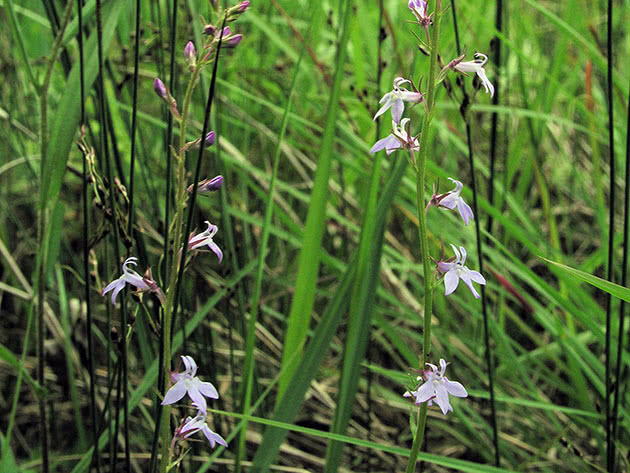
Lobelia gerardii
stands the temperature up to -20º F, 4.1 ft high, the flowers are collected in a spicate inflorescence. The most famous variety is Vedrariensis.
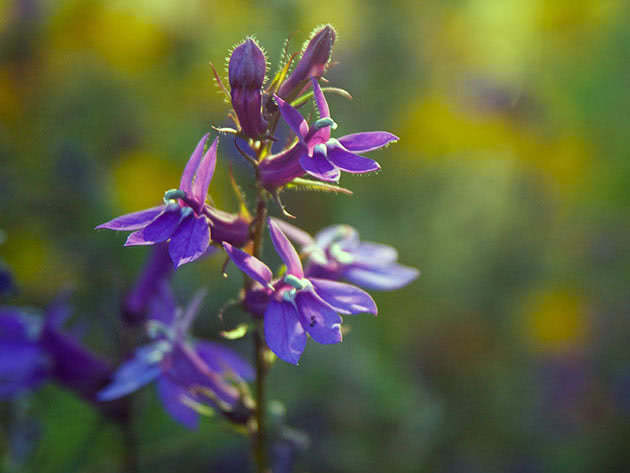
Lobelia cardinalis
or cardinal flower, reaches 3.3 ft in height. It was named so since the flower color was similar to the color of the vesture of Roman Catholic Cardinals.

Blue and lilac flowers of poisonous lobelia sessilifolia (Chinese lobelia) are collected in a bare apical one-sided truss. The species is winter-hardy, but if winter is very cold or snowless, it is better to mulch the site with this lobelia.

Lobelia siphilitica
or great blue lobelia, was brought to Europe from America. Blue-violet flowers of this species are collected in dense spicate inflorescences. The name of the species comes from the word “syphilis”, because it was believed that the plant cured this disease, although eventually it came clear that it was not true. The species was not popular in the Old World, but it became one of the parents of a group of popular hybrids, for example, such as Complement that was the result of crossing of great blue lobelia, cardinal lobelia and lobelia fulgens.
